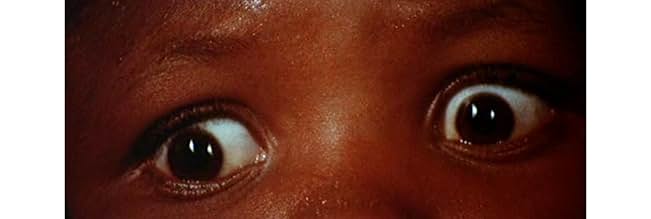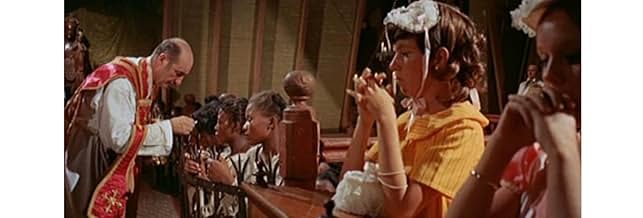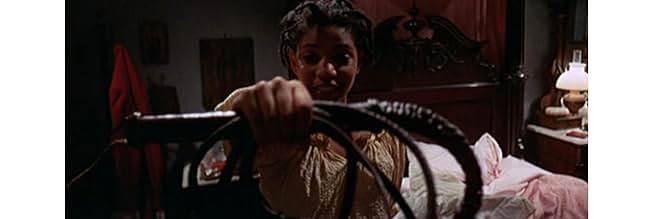CALIFICACIÓN DE IMDb
6.5/10
2 k
TU CALIFICACIÓN
Dos realizadores de documentales retroceden en el tiempo hasta el sur de los Estados Unidos antes de la Guerra Civil para filmar la trata de esclavos.Dos realizadores de documentales retroceden en el tiempo hasta el sur de los Estados Unidos antes de la Guerra Civil para filmar la trata de esclavos.Dos realizadores de documentales retroceden en el tiempo hasta el sur de los Estados Unidos antes de la Guerra Civil para filmar la trata de esclavos.
- Dirección
- Guionistas
- Elenco
Dick Gregory
- Self
- (sin créditos)
Gualtiero Jacopetti
- Self
- (sin créditos)
Ernest Kubler
- Whip
- (sin créditos)
Yayoi Kusama
- Self
- (sin créditos)
Franco Prosperi
- Self
- (sin créditos)
Shelley Spurlock
- Girl
- (sin créditos)
- Dirección
- Guionistas
- Todo el elenco y el equipo
- Producción, taquilla y más en IMDbPro
Opiniones destacadas
The story goes that when this played Times Square it caused a riot. I have no idea if its true or not, but if it did happen I can see why.
The film is an examination of race relations that focuses on slavery. As an indictment of the institution of slavery this film can not be topped. This is a nightmarish look at what slave mills must have been like almost 200 years ago.
The film exists in two versions that are very different different, and if you ever wanted to see how one film could end up as two different films, look no farther than this film (both versions are in the Mondo Cane box set)
Both films contain much of the same footage cut for different effect.The original Italian cut deals more heavily with race relations now, while the American version deals more with the slavery aspect. The final moments of both versions makes more sense in context of the Italian version since in the final moments we see that in many ways things have not gotten all that much better for the black race. Both films also have a good amount of footage unique to that version. I doubt seriously that the footage could be combined to make one super film since you'd end up with a third film with a third point of view.
I like both versions of the film. I think that right or wrong this is a film that will get you talking and thinking and wondering, which is what the film is suppose to do. I can't say that one is better than the other, both are flawed, however both should be seen, preferably with in a day or so of each other since the duel versions play off each other in unexpected ways.
See these films., But be prepared to get angry. You may not get through them, you may not like them, but you will be provoked into a reaction on some level. For better or worse you will be challenged and moved which is what the point of the film is.
9 out of 10.
The film is an examination of race relations that focuses on slavery. As an indictment of the institution of slavery this film can not be topped. This is a nightmarish look at what slave mills must have been like almost 200 years ago.
The film exists in two versions that are very different different, and if you ever wanted to see how one film could end up as two different films, look no farther than this film (both versions are in the Mondo Cane box set)
Both films contain much of the same footage cut for different effect.The original Italian cut deals more heavily with race relations now, while the American version deals more with the slavery aspect. The final moments of both versions makes more sense in context of the Italian version since in the final moments we see that in many ways things have not gotten all that much better for the black race. Both films also have a good amount of footage unique to that version. I doubt seriously that the footage could be combined to make one super film since you'd end up with a third film with a third point of view.
I like both versions of the film. I think that right or wrong this is a film that will get you talking and thinking and wondering, which is what the film is suppose to do. I can't say that one is better than the other, both are flawed, however both should be seen, preferably with in a day or so of each other since the duel versions play off each other in unexpected ways.
See these films., But be prepared to get angry. You may not get through them, you may not like them, but you will be provoked into a reaction on some level. For better or worse you will be challenged and moved which is what the point of the film is.
9 out of 10.
I viewed this particular film in the summer of 1972 in New York City. I remember that it was opening day and the turnout was surprisingly large. The other thing that I remembered was that I thought the filmmakers had taken an original approach as far as their documentary-style on slavery. As if I were actually there, watching the events take place. As an African-American man, I found the film fascinating and enlightening. The only thing I did find questionable was, once again, the Black man was depicted as a sexual beast with over-sized reproductive organs. I do believe that this, to some, is what made the movie so titillating. Overall, I still had a pleasant movie going experience. I would like to ask any readers of this commentary that if they have any knowledge of how I may a obtain a copy of this film to please contact me through my e-mail.
Anyone thinking of checking this film out: be warned, words can not express what an awesomely brutal experience it is to sit through. I'm a big fan of horror films, but nothing I ever saw came close to the feeling of revulsion this 30 plus year old film gave me. Trust me, you will have to use the fast forward button on your remote control several times sitting through this one.
A group of Italian journalists goes back in time to America during the time of slavery and documents what they see. The viewer is spared no amount of detail as we are shown what it was like to travel aboard a slave ship, be sold in market as common livestock, be raped, tortured hunted and killed, and basically denied even the slightest bit of human empathy or compassion at every turn.
While Roots covered the same subject matter a whole lot better, it came nowhere near delivering the visceral reaction of this film. For that reason, I recommend people watch Goodbye Uncle Tom. While by no means a great film, if society is truly never to forget the injustices and wrongs of the past, work like this is necessary viewing.
A group of Italian journalists goes back in time to America during the time of slavery and documents what they see. The viewer is spared no amount of detail as we are shown what it was like to travel aboard a slave ship, be sold in market as common livestock, be raped, tortured hunted and killed, and basically denied even the slightest bit of human empathy or compassion at every turn.
While Roots covered the same subject matter a whole lot better, it came nowhere near delivering the visceral reaction of this film. For that reason, I recommend people watch Goodbye Uncle Tom. While by no means a great film, if society is truly never to forget the injustices and wrongs of the past, work like this is necessary viewing.
MONDO CANE and AFRICA ADDIO creators Gualtiero Jacopetti and Franco E. Prosperi take us on a journey through time, back to the mid 1800's, not too long before the civil war. The movie is styled like one of their previous documentaries, with actors talking to the camera as though being interviewed, and just about every form of human cruelty being enacted on the Africans who have been dragged overseas to become slaves.
The movie is certainly disturbing, and it did indeed enrage me that ancestors of mine took part in this treatment of fellow human beings. But the movie lost me whenever it tried to create a parallel between the climate between blacks and whites in the 1800s and the 1960s.
Not that there weren't (and, unfortunately, still are) problems with racial tension in this country, but the movie seems to think that the average black person is still a savage at heart, just waiting for the right moment to break out an axe and slaughter the first white person he comes across. The movie climaxes with a radical black man reading The Diary of Nat Turner and imagining doing just that, including a horrific moment in which he smashes a baby's head against the wall.
To me, the movie seems to have a negative opinion of just about everyone. Obviously, due to its decidedly anti-slavery stance, the slave traders are viewed as sick, inhuman monsters with only the faintest mask of civility on the surface. But the African characters are portrayed largely as ignorant buffoons, too dim-witted to understand what's happening to them.
Later, during the modern day scenes, the sole black character is shown as having a major chip on his shoulder that has driven him nearly insane with rage, while the white people are a bunch of care-free bubble heads. Such generalizations and lack of depth or character development greatly lessens the power the movie may have had.
But, as a purely gut-busting exercise in sleaze and disgusting imagery, GOODBYE UNCLE TOM sits confidently alongside other such gross-out movies as CANNIBAL HOLOCAUST, SALO and MEN BEHIND THE SUN. Also, like those movies, GUT (hmmm, interesting abbreviation) goes so outrageously over-the-top in depicting its atrocities, most of the movie's true power is lost, and it becomes little more than a freak show.
I hesitantly recommend the movie for fans of sick cinema as a curiosity. I warn pretty much everyone else to stay far, far away.
The movie is certainly disturbing, and it did indeed enrage me that ancestors of mine took part in this treatment of fellow human beings. But the movie lost me whenever it tried to create a parallel between the climate between blacks and whites in the 1800s and the 1960s.
Not that there weren't (and, unfortunately, still are) problems with racial tension in this country, but the movie seems to think that the average black person is still a savage at heart, just waiting for the right moment to break out an axe and slaughter the first white person he comes across. The movie climaxes with a radical black man reading The Diary of Nat Turner and imagining doing just that, including a horrific moment in which he smashes a baby's head against the wall.
To me, the movie seems to have a negative opinion of just about everyone. Obviously, due to its decidedly anti-slavery stance, the slave traders are viewed as sick, inhuman monsters with only the faintest mask of civility on the surface. But the African characters are portrayed largely as ignorant buffoons, too dim-witted to understand what's happening to them.
Later, during the modern day scenes, the sole black character is shown as having a major chip on his shoulder that has driven him nearly insane with rage, while the white people are a bunch of care-free bubble heads. Such generalizations and lack of depth or character development greatly lessens the power the movie may have had.
But, as a purely gut-busting exercise in sleaze and disgusting imagery, GOODBYE UNCLE TOM sits confidently alongside other such gross-out movies as CANNIBAL HOLOCAUST, SALO and MEN BEHIND THE SUN. Also, like those movies, GUT (hmmm, interesting abbreviation) goes so outrageously over-the-top in depicting its atrocities, most of the movie's true power is lost, and it becomes little more than a freak show.
I hesitantly recommend the movie for fans of sick cinema as a curiosity. I warn pretty much everyone else to stay far, far away.
When I first saw GOODBYE UNCLE TOM several years ago on a muddy bootleg, the level of production value that went into this "shockumentary" impressed me. I was amazed that the filmmakers were able to corral literally hundreds of Black people into degrading and de-humanizing reenactments of various aspects of slavery. But I also understood that this was a very special film for that exact reason. Unlike American films about slavery, it makes no effort to excuse or sugarcoat this heinous act. Like the opening of Bunuel's Un Chien Andalou, the filmmakers intent is to force you to open your eyes to the truthful horrors of this 400 year old practice.
The premise of the film is brilliant--an Italian documentary film crew is transported "back in time" to interview and bear witness to American Slavery on all levels--from rich slave owners, to the "veterinarian" who must clean and delouse the slaves, to the poor whites who don't own slaves but invade their quarters for the purposes of rape this movie holds nothing back, etc. It loses points for some gratuitous nudity and violence (Mandingo, anyone?), and it's contemporary ending (which tries to connect the Black Power movement and the Nat Turner 1831 slave revolt) is somewhat muddled and clearly designed to leave viewers terrified. The concept that Black men still hate white people but crave their women but would prefer to kill them rather than make love to them is an idea better tackled in the film version of Baraka's DUTCHMAN. If the film were made a few years later it might end by raising the question of whether or not Black are still enslaved--not by carnal lust, but in a prison of the mind.
But the recent DVD release of this film (and its Director's Cut) brings to light two things the shoddy bootlegs didn't. (1) Unlike typical grindhouse exploitation, this is first and foremost a work of art--the opening shot, taken from a helicopter flying over a plantation over a field of slaves, then drawing low enough to blow away the bales of cotton and causing the slaves to flee in glee is GENIUS. Every image and idea is incredibly thought out. The score is up there with the best of Morricone and Rota . The photography and widescreen compositions are top-notch.
However, it is unsettling to discover (2), most of the film was shot in Haiti with the full cooperation of mercenary dictator "Papa Doc" Duvaluier and the Tontons Macoutes (who probably had no problem getting hundreds of Hatian natives willing to degrade and dehumanize themselves for the purpose of making a film). ). In the end, this is a painful film to watch on many levels, but deserves to be seen alongside Alex Haley's ROOTS. 8.5/10 Stars.
The premise of the film is brilliant--an Italian documentary film crew is transported "back in time" to interview and bear witness to American Slavery on all levels--from rich slave owners, to the "veterinarian" who must clean and delouse the slaves, to the poor whites who don't own slaves but invade their quarters for the purposes of rape this movie holds nothing back, etc. It loses points for some gratuitous nudity and violence (Mandingo, anyone?), and it's contemporary ending (which tries to connect the Black Power movement and the Nat Turner 1831 slave revolt) is somewhat muddled and clearly designed to leave viewers terrified. The concept that Black men still hate white people but crave their women but would prefer to kill them rather than make love to them is an idea better tackled in the film version of Baraka's DUTCHMAN. If the film were made a few years later it might end by raising the question of whether or not Black are still enslaved--not by carnal lust, but in a prison of the mind.
But the recent DVD release of this film (and its Director's Cut) brings to light two things the shoddy bootlegs didn't. (1) Unlike typical grindhouse exploitation, this is first and foremost a work of art--the opening shot, taken from a helicopter flying over a plantation over a field of slaves, then drawing low enough to blow away the bales of cotton and causing the slaves to flee in glee is GENIUS. Every image and idea is incredibly thought out. The score is up there with the best of Morricone and Rota . The photography and widescreen compositions are top-notch.
However, it is unsettling to discover (2), most of the film was shot in Haiti with the full cooperation of mercenary dictator "Papa Doc" Duvaluier and the Tontons Macoutes (who probably had no problem getting hundreds of Hatian natives willing to degrade and dehumanize themselves for the purpose of making a film). ). In the end, this is a painful film to watch on many levels, but deserves to be seen alongside Alex Haley's ROOTS. 8.5/10 Stars.
¿Sabías que…?
- TriviaThe movie was originally released in Italy in a 119-minute version and immediately withdrawn when the directors were sued for plagiarism by writer Joseph Chamberlain Furnas. It was re-released in March 1972 in a re-cut 136-minute version under the title 'Zio Tom.'
- Créditos curiosos'Questo film è un documentario. I fatti sono storicamente avvenuti ed i personaggi sono realmente esistiti.' Which translates to: 'This film is a documentary. The facts historically happened and the persons really existed.'
- Versiones alternativasBefore receiving a UK cinema certificate in 1973 the film was extensively cut by around 30 minutes by the BBFC with heavy edits to rape scenes, footage of sexual experiments, graphic violence, the fantasy murder sequence, and the opening scenes on the slave ship.
- ConexionesFeatured in Adam & Yves (1974)
Selecciones populares
Inicia sesión para calificar y agrega a la lista de videos para obtener recomendaciones personalizadas
- How long is Goodbye Uncle Tom?Con tecnología de Alexa
Detalles
- Fecha de lanzamiento
- País de origen
- Idiomas
- También se conoce como
- Goodbye Uncle Tom
- Locaciones de filmación
- Port-au-Prince, Haiti(Majority of interiors and exteriors)
- Productora
- Ver más créditos de la compañía en IMDbPro
Contribuir a esta página
Sugiere una edición o agrega el contenido que falta










